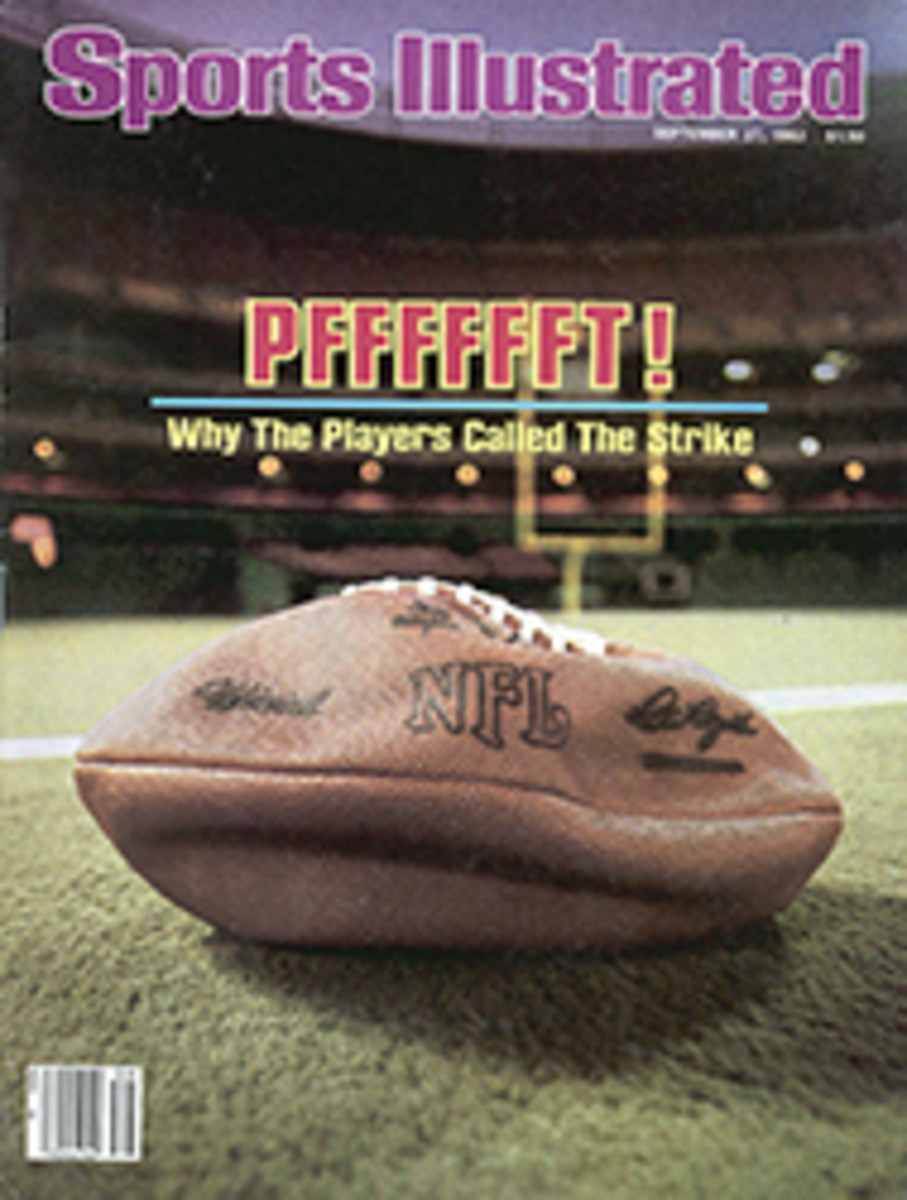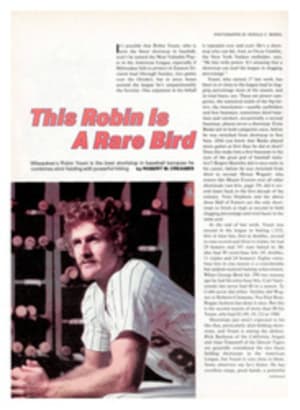
A LIVELY NEW SOFTBALL SPEEDS UP THE ACTION BUT SLOWS DOWN THE GAME
Slow-pitch softball is facing a crisis. It has to do not with the game itself, but the ball. At issue are a number of new, lively softballs that have hit the market. They have exotic names like the T-4000, manufactured by Dudley; the Rocket from deBeer; the Hot Dot from Worth; and the TN-Poly by Wilson. The main difference between the new balls and the traditional one is the core. In the old ball the core is cork; in the new balls it's a plastic similar to that used in the cover on a golf ball. The synthetic-center ball leaves the bat much faster and carries farther than the cork-center ball. And therein lie the problems.
The first is extended game time. Because of the ball's jackrabbit jump, more home runs are being hit and more runs are being scored, adding an average of 20 to 30 minutes to games in which the new ball is used. This angers the umpires, who are paid by the game not by the hour, and distresses tournament organizers because their schedules are getting all bollixed up.
The second problem is the potential for injury. Pitchers, who stand only 46 feet from home plate, are wary of the way the new balls zip off the bat. So are first and third basemen. And for every player, keeping your eye on the ball is now more imperative than ever.
Fred Wampnar of the United States Testing Company has analyzed the balls for the Amateur Softball Association, the governing body of the sport. While he admits that the difference in rebound capacity between the traditional softball and the new one is "interesting," he refuses to disclose the actual figures and refers all questions to the ASA executive director, Don Porter. At ASA headquarters in Oklahoma City, Porter says, "The new balls are certainly very lively in comparison to other balls. In the drop test, where balls are dropped from a height of 20 feet and the rebound measured, the cork-center balls averaged a rebound of 57 inches, while the synthetic-center balls averaged 63 inches."
As a result, says Doug Bennett, sales manager at Worth, "There are people hitting home runs who wouldn't be under normal circumstances. But that's the reason they're playing. They like to hit home runs. It's a big deal for the people who've never hit one. And for the guy who hits only one in his life, that one's going to be more exciting to him than homers are to the guy who hits them by the hundred."
But Porter, an advocate of traditional softball, is disturbed. "Perhaps the balls are too lively for competition," he admits. "Fast-pitch softball is a game dominated by the pitcher. Slow-pitch came along to make the game more fun. It's a game dominated by the hitter. It gives a lot of people something to do that's competitive and still fun. Slow-pitch is a great game and I don't like to see anything done to disrupt it."
Although slow-pitch was designed to be a high-scoring game, traditionalists wonder if the lively-ball version is really softball at all. Richard Pollak is vice-president of sales for deBeer, but he's a softball purist, too, and he doesn't think so. "I don't like it," he says. "I think the lively ball is terrible for the game. It makes it a home-run derby. Frankly, it makes me sick. I don't believe the game was designed so that 65-year-old women would be able to hit homers. And that's just about where we are now."
Ed Andrews, the metropolitan Miami ASA commissioner, agrees. "Now, the only thing a lot of these players can do is hit home runs," he says. "They're too big or uncoordinated to play the game the way it is supposed to be played. To have scores like 80 to 42, which we've had, isn't Softball. I'll take a good 18-16 or 13-9 game anytime."
Some local organizers have temporarily solved the players-love-it, umpires-hate-it conflict by banning the balls from local tournaments until the ASA makes a final decision.
The question of whether the ball is more dangerous than the standard ball is another, murkier issue. Of the 30 million softball players in the U.S., 82% play slow-pitch. While the use of the lively ball is more prevalent in the South than in other parts of the country, injuries in general are increasing. And one player was killed by a softball this season. Lazaro Garcia, 18, of the Miami Cuban League, died of cardiac arrest when he was hit in the chest by a line drive. The ball used in the game, however, was not one of the new ones. In Birmingham, Ala., a third-base coach was seriously injured when a cork ball hit him in the temple. But the consensus of those at the scene was that he was watching the dugout instead of the ball. He has recovered.
Merle Butler, ASA's national supervisor of umpires, had heard so much talk about players being hurt that he asked the local associations to document individual injuries last March, April and May. He hoped to get data to determine if the new ball really is a hazard, but the results of his survey have been so vague that he's unable to ascertain whether the increase in injuries is substantial, and whether they're the result of any particular ball or bat or an influx of new players. Says Porter, "If you get hit with any ball it's going to hurt. It's not a soft ball. That's a misnomer."
Nevertheless, a Dallas association recently banned the T-4000 because a player suffered facial injuries when one took a bad hop, but didn't ban the Rocket, the Hot Dot, or the TN-Poly, an action the Dudley people consider unfair. "All the new balls are essentially the same in hardness and reaction off the bat," says Marge Miller, assistant to Dudley's executive vice-president, Tom Faimali. "The initial reaction to the ball was fantastic, and it still would be if some local associations hadn't interfered. The reluctance to use the ball is based on misinformation that it's dangerous. I'm sure that when the first solid-core balls came out, the players had to change their reaction time just as they do now."
The ASA has banned the lively balls from national competition but otherwise has left the question of their use up to local officials. Meanwhile the ASA is considering whether to outlaw the balls at the local level. A decision should be forthcoming early next year.
"We're testing to find the standards we want in the balls used in our national tournaments," says Porter. "The Amateur Softball Association is trying to establish criteria with which to measure the resiliency and the rebound of soft-balls because the Association wants to control the speed of the ball and the distance that it carries. Our primary concerns are safety and maintaining a ball that will stay inside the park. You've got to maintain the sense of competition. When you've got nothing but guys hitting homer after homer, nobody is doing anything except the pitcher and the man trotting around the bases. There are nine other guys out there who want to play, too.
Meanwhile, the manufacturers are caught in the middle. They were certain the balls would be sanctioned, because separately each component has been approved. "The players should get together and tell the associations if they want to use the balls," said one manufacturer. "Who's the game really for—the players or the associations?"
The Sporting Goods Manufacturers Association would, of course, prefer a solution that would satisfy both the players and the organizers of the leagues and tournaments. One suggestion of theirs was to move the park fences back to accommodate the lively balls, but this would be costly, and in most parks there is simply no room.
Until the ASA makes up its mind, manufacturers are holding back on full-scale production, but the players aren't holding back. They're having the time of their lives hitting the long ball and breaking out the home-run trot.
ILLUSTRATION
NED LEVINE

